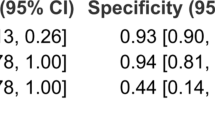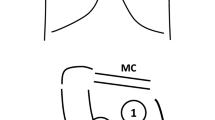Abstract
Background
Lung ultrasound (LUS) may accurately diagnose pneumothorax. However, there is uncertainty about its usefulness in the quantification of pneumothorax size. To determine the ability of LUS in the semi-quantification of pneumothorax volume, we compared the projection of the lung point (LP) with the pneumothorax volume measured by computerized tomography (CT) and the interpleural distance on chest radiography (CXR).
Methods
We performed LUS in patients with pneumothorax and all the LP located on the chest wall were compared to CXR and CT studies. The primary outcome of the study was the ability of LP to grade pneumothorax volumes measured by CT. The secondary outcome was the accuracy of LP to predict small and large pneumothorax according to the societal guidelines based on CXR reading.
Results
A total of 124 patients with pneumothorax were enrolled (76 spontaneous, 20 traumatic and 28 post-procedural). Ninety-four CXR and 58 CT were available for the analysis. An LP posterior to the mid axillary line corresponded to three different CXR criteria for large pneumothorax with sensitivity from 81.4 to 88.2 % and specificity from 64.7 to 72.6 %. The mid axillary line also represented the limit for predicting greater than 15 % of lung collapse when volume is measured at CT, with sensitivity 83.3 % and specificity 82.4 %.
Conclusions
LUS-targeted assessment of LP was a useful predictor of pneumothorax volume in this research study setting. LUS reliably classified pneumothorax size when compared to criteria based on CXR reading, particularly the small sized pneumothorax. However, LUS greatly outperformed conventional CXR reading for a graded quantification of the percentage of lung collapse.
Similar content being viewed by others
References
Volpicelli G (2011) Sonographic diagnosis of pneumothorax. Intensive Care Med 37:224–232
Blaivas M, Lyon M, Duggal S (2005) A prospective comparison of supine chest radiography and bedside ultrasound for the diagnosis of traumatic pneumothorax. Acad Emerg Med 12:844–849
Lichtenstein DA, Meziere G, Lascols N, Biderman P, Courret JP, Gepner A, Goldstein I, Tenoudji-Cohen M (2005) Ultrasound diagnosis of occult pneumothorax. Crit Care Med 33:1231–1238
Reissig A, Kroegel C (2005) Accuracy of transthoracic sonography in excluding post-interventional pneumothorax and hydropneumothorax. Comparison to chest radiography. Eur J Radiol 53:463–470
Soldati G, Testa A, Sher S, Pignataro G, La Sala M, Silveri NG (2008) Occult traumatic pneumothorax: diagnostic accuracy of lung ultrasonography in the emergency department. Chest 133:204–211
Lichtenstein D, Meziere G, Biderman P, Gepner A (2000) The “lung point”: an ultrasound sign specific to pneumothorax. Intensive Care Med 26:1434–1440
Volpicelli G, Elbarbary M, Blaivas M, Lichtenstein DA, Mathis G, Kirkpatrick AW, Melniker L, Gargani L, Noble VE, Via G, Dean A, Tsung JW, Soldati G, Copetti R, Bouhemad B, Reissig A, Agricola E, Rouby JJ, Arbelot C, Liteplo A, Sargsyan A, Silva F, Hoppmann R, Breitkreutz R, Seibel A, Neri L, Storti E, Petrovic T, International Liaison Committee on Lung Ultrasound for International Consensus Conference on Lung Ultrasound (2012) International evidence-based recommendations for point-of-care lung ultrasound. Intensive Care Med 38:577–591
Lichtenstein DA (2007) Ultrasound in the management of thoracic disease. Crit Care Med 35:S250–S261
Baumann MH, Noppen M (2004) Pneumothorax. Respirology 9:157–164
Henry M, Arnold T, Harvey J, Pleural Diseases Group SoCCBTS (2003) BTS guidelines for the management of spontaneous pneumothorax. Thorax Suppl 2:ii39–ii52
de Moya MA, Seaver C, Spaniolas K, Inaba K, Nguyen M, Veltman Y, Shatz D, Alam HB, Pizano L (2007) Occult pneumothorax in trauma patients: development of an objective scoring system. J Trauma 63:13–17
Wolfman NT, Gilpin JW, Bechtold RE, Meredith JW, Ditesheim JA (1993) Occult pneumothorax in patients with abdominal trauma: CT studies. J Comput Assist Tomogr 17:56–59
Baumann MH, Strange C, Heffner JE, Light R, Kirby TJ, Klein J, Luketich JD, Panacek EA, Sahn SA, Group APC (2001) Management of spontaneous pneumothorax: an American College of Chest Physicians Delphi consensus statement. Chest 119:590–602
De Leyn P, Lismonde M, Ninane V, Noppen M, Slabbynck H, Van Meerhaeghe A, Van Schil P, Vermassen F (2005) Guidelines Belgian Society of Pneumology. Guidelines on the management of spontaneous pneumothorax. Acta Chir Belg 105:265–267
Kelly AM, Druda D (2008) Comparison of size classification of primary spontaneous pneumothorax by three international guidelines: a case for international consensus? Respir Med 102:1830–1832
Engdahl O, Toft T, Boe J (1993) Chest radiograph–a poor method for determining the size of a pneumothorax. Chest 103:26–29
Hoi K, Turchin B, Kelly AM (2007) How accurate is the Light index for estimating pneumothorax size? Australas Radiol 51:196–198
Wilkerson RG, Stone MB (2010) Sensitivity of bedside ultrasound and supine anteroposterior chest radiographs for the identification of pneumothorax after blunt trauma. Acad Emerg Med 17:11–17
Kiley S, Tighe P, Hajibrahim O, Deitte L, Gravenstein N, Robinson A 3rd (2013) Retrospective computed tomography mapping of intrapleural air may demonstrate optimal window for ultrasound diagnosis of pneumothorax. J Intensive Care Med. doi:10.1177/0885066613488735
Volpicelli G, Boero E, Stefanone V, Storti E (2013) Unusual new signs of pneumothorax at lung ultrasound. Crit Ultrasound J 5:10. doi:10.1186/2036-7902-5-10
Druda D, Kelly AM (2009) What is the difference in size of spontaneous pneumothorax between inspiratory and expiratory X-rays? Emerg Med J 26:861–863
Choi BG, Park SH, Yun EH, Chae KO, Shinn KS (1998) Pneumothorax size: correlation of supine anteroposterior with erect posteroanterior chest radiographs. Radiology 209:567–569
Collins CD, Lopez A, Mathie A, Wood V, Jackson JE, Roddie ME (1995) Quantification of pneumothorax size on chest radiographs using interpleural distances: regression analysis based on volume measurements from helical CT. AJR Am J Roentgenol 165:1127–1130
O’Rourke JP, Yee ES (1989) Civilian spontaneous pneumothorax. Treatment options and long-term results. Chest 96:1302–1306
Flint K, Al Hilawi AH, Johnson NM (1984) Conservative management of spontaneous pneumothorax. Lancet ii:687–688
Ball CG, Kirkpatrick AW, Feliciano DV (2009) The occult pneumothorax: what have we learned? Can J Surg 52:E173–E179
Ball CG, Kirkpatrick AW, Fox DL, Laupland KB, Louis LJ, Andrews GD, Dunlop MP, Kortbeek JB, Nicolaou S (2006) Are occult pneumothoraces truly occult or simply missed? J Trauma 60:294–298
Ball CG, Kirkpatrick AW, Laupland KB, Fox DL, Litvinchuk S, Dyer DM, Anderson IB, Hameed SM, Kortbeek JB, Mulloy R (2005) Factors related to the failure of radiographic recognition of occult posttraumatic pneumothoraces. Am J Surg 189:541–546
Roberts DJ, Ball CG, Tiruta C, Kirkpatrick AW (2011) Image of the month. Tension occult pneumothorax. Arch Surg 146:1211–1212
Volpicelli G, Cardinale L, Berchialla P, Mussa A, Bar F, Frascisco MF (2012) A comparison of different diagnostic tests in the bedside evaluation of pleuritic pain in the ED. Am J Emerg Med 30:317–324
Agricola E, Arbelot C, Blaivas M, Bouhemad B, Copetti R, Dean A, Dulchavsky S, Elbarbary M, Gargani L, Hoppmann R, Kirkpatrick AW, Lichtenstein D, Liteplo A, Mathis G, Melniker L, Neri L, Noble VE, Petrovic T, Reissig A, Rouby JJ, Seibel A, Soldati G, Storti E, Tsung JW, Via G, Volpicelli G (2011) Ultrasound performs better than radiographs. Thorax 66:828–829
Blondeau B, Delour P, Bedon-Carte S, Leger MS, Chimot L (2012) Lung ultrasound to avoid catastrophic care for false pneumothorax. Intensive Care Med 38:1410–1411
Xirouchaki N, Kondili E, Prinianakis G, Malliotakis P, Georgopoulos D (2014) Impact of lung ultrasound on clinical decision making in critically ill patients. Intensive Care Med 40:57–65
Sistrom CL, Reiheld CT, Gay SB, Wallace KK (1996) Detection and estimation of the volume of pneumothorax using real-time sonography: efficacy determined by receiver operating characteristic analysis. AJR Am J Roentgenol 166:317–321
Oveland NP, Lossius HM, Wemmelund K, Stokkeland PJ, Knudsen L, Sloth E (2013) Using thoracic ultrasonography to accurately assess pneumothorax progression during positive pressure ventilation: a comparison with CT scanning. Chest 143:415–422
Moore FO, Goslar PW, Coimbra R, Velmahos G, Brown CV, Coopwood TB Jr, Lottenberg L, Phelan HA, Bruns BR, Sherck JP, Norwood SH, Barnes SL, Matthews MR, Hoff WS, de Moya MA, Bansal V, Hu CK, Karmy-Jones RC, Vinces F, Pembaur K, Notrica DM, Haan JM (2011) Blunt traumatic occult pneumothorax: is observation safe?–results of a prospective, AAST multicenter study. J Trauma 70:1019–1023
Galbois A, Ait-Oufella H, Baudel JL, Kofman T, Bottero J, Viennot S, Rabate C, Jabbouri S, Bouzeman A, Guidet B, Offenstadt G, Maury E (2010) Pleural ultrasound compared with chest radiographic detection of pneumothorax resolution after drainage. Chest 138:648–655
Enderson BL, Abdalla R, Frame SB, Casey MT, Gould H, Maull KI (1993) Tube thoracostomy for occult pneumothorax: a prospective randomized study of its use. J Trauma 35:726–729
Brasel KJ, Stafford RE, Weigelt JA, Tenquist JE, Borgstrom DC (1999) Treatment of occult pneumothoraces from blunt trauma. J Trauma 46:987–990
Kirkpatrick AW, Rizoli S, Ouellet JF, Roberts DJ, Sirois M, Ball CG, Xiao ZJ, Tiruta C, Meade M, Trottier V, Zhu G, Chagnon F, Tien H, Canadian Trauma Trials Collaborative and the Research Committee of Trauma Association of Canada (2013) Occult pneumothoraces in critical care: a prospective multicenter randomized controlled trial of pleural drainage for mechanically ventilated trauma patients with occult pneumothoraces. J Trauma Acute Care Surg 74:747–754
Ouellet JF, Trottier V, Kmet L, Rizoli S, Laupland K, Ball CG, Sirois M, Kirkpatrick AW (2009) The OPTICC trial: a multi-institutional study of occult pneumothoraces in critical care. Am J Surg 197:581–586
O’Connor AR, Morgan WE (2005) Radiological review of pneumothorax. BMJ 330:1493–1497
Seow A, Kazerooni EA, Pernicano PG, Neary M (1996) Comparison of upright inspiratory and expiratory chest radiographs for detecting pneumothoraces. AJR Am J Roentgenol 166:313–316
Volpicelli G, Audino B (2011) The double lung point: an unusual sonographic sign of juvenile spontaneous pneumothorax. Am J Emerg Med 29:355.e1–355.e2
Volpicelli G, Garofalo G, Lamorte A, Frascisco MF (2012) Images in emergency medicine. Young man with left thoracic pain. Recurrent pneumothorax after failed pleurodesis. Ann Emerg Med 60:e3–e4
Volpicelli G, Lamorte A, Tullio M, Boero E, Stefanone V (2013) Worsening dyspnea and cough following thoracentesis. Chest 144:e1–e3
Acknowledgments
Support was provided solely from institutional and/or departmental sources. No sponsor funded the study.
Conflicts of interest
The authors have reported that no potential conflicts of interest exist with any companies/organizations whose products or services may be discussed in this article.
Author information
Authors and Affiliations
Corresponding author
Additional information
Take-home message: Lung ultrasound is useful to semi-quantify the size of pneumothorax at bedside by the localization of the lung point on the chest wall. The lateral progression of the lung point corresponds to significant increase in the entity of pneumothorax volumes.
Trial registry: Clinicaltrials.gov no. NCT01572584 (http://www.clinicaltrials.gov).
Electronic supplementary material
Below is the link to the electronic supplementary material.
Supplementary material 4 (MPG 3502 kb)
Rights and permissions
About this article
Cite this article
Volpicelli, G., Boero, E., Sverzellati, N. et al. Semi-quantification of pneumothorax volume by lung ultrasound. Intensive Care Med 40, 1460–1467 (2014). https://doi.org/10.1007/s00134-014-3402-9
Received:
Accepted:
Published:
Issue Date:
DOI: https://doi.org/10.1007/s00134-014-3402-9




